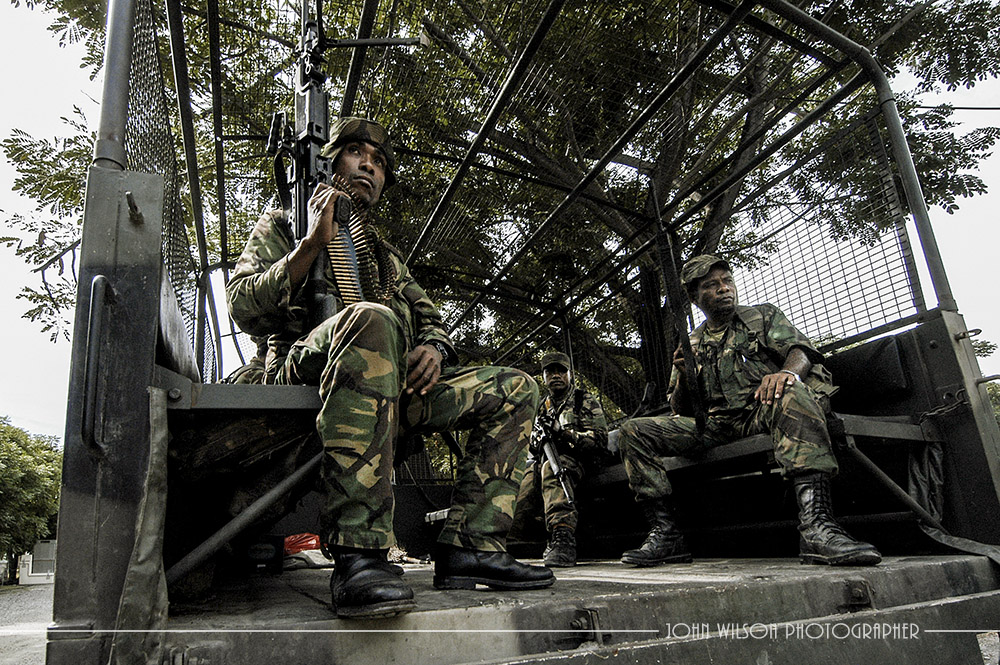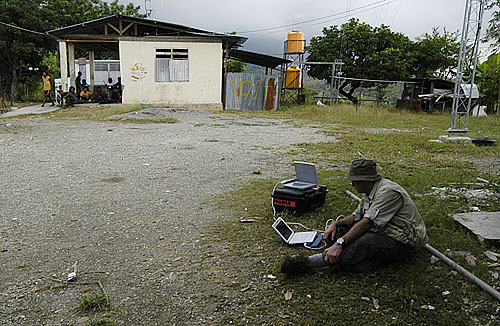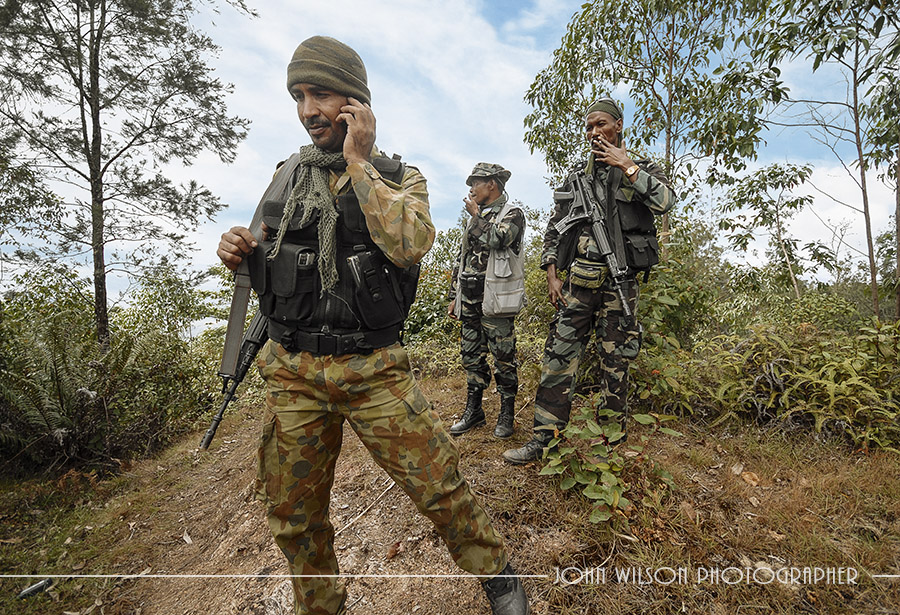
News photojournalism in East Timor for Time Magazine New York
A Return To Unrest
It had been six years since I was last in East Timor covering the tumultuous events that led to the diminutive nation's lunge for independence. The violence and destruction suffered by the East Timorese at the hands of Indonesian militias was nothing short of atrocious and once again the resilient population's resolve would be tested.
In May of 2006, I found myself back in the capital, Dili, on a Time Magazine assignment, to once again cover brewing unrest. This time the difference was East Timorese fighting against themselves. It seemed that in the ensuing years since independence a form of racial tension, between the easterners and the westerners had started to develop. This tension was bought to international awareness when a large number of the East Timorese defence force quit alleging bias and a lack of opportunity for promotion which they felt was based on racial favor.

The tension erupted in March of 2006 when a peaceful protest march held by the former soldiers and supporters turned into a blood bath of shooting as heavily armed police and soldiers were ordered to end the gathering. As a result of this incident two of the defence force commanders, fled to the mountains in disgust at being given orders to shoot their own people. The two commanders were followed by a collection of supporters and defectors from the military and police forces.

Turmoil in Dili
Arriving in Dili with TIME magazine writer Rory Callinan we were exposed to a city in turmoil. Gangs of angry youths were stalking the streets while on the outskirts of the city, soldiers and police officers pitted their lethal efforts against the now retaliating protestors or "petitioners", as they were called, and their supporters. While the majority of the media stayed in Dili and focused on the street gangs we knew the real story was in the mountains surrounding the capital with the two "rebel" commanders that had left the army in disgust with their men after the events in March. We decided to make the perilous journey into the mountains amidst heavy gunfire between the remaining East Timorese army and the heavily armed rebel soldiers and their police supporters. Taking to steep mountain pathways with fleeing villagers we dodged curtains of gunfire flying over us. I managed to make a few photographs on the way up the mountain of the fleeing locals but we had to climb fast to get out of the torrents of gunfire around us. On some occasions, we lay on the ground among terrified locals with bullets shredding the trees and bushes above us. I was the only photojournalist to make it into the rebel-held mountain positions at this crucial point in the battles.

East Timorese take cover on the ground as heavy gunfire peppers the mountainside near Dili.

I was immensely relieved when we finally made it to a rebel position at a telecommunications tower on a mountain top overlooking Dili. We were warmly greeted by a nervous platoon of rebel soldiers, police and civilians (about 30 people in total) who were taking orders via radio from the rebel commander Alfred Reinado who was controlling another section of the mountains with a unit of soldiers and police. I managed to send a batch of photos via my satellite link to the Time magazine editor before afternoon thunderstorms swept in.

John Wilson Photographer filing images via satellite to TIME magazine from mountain top in East Timor.
As evening fell and a tropical storm approached the heavy gunfire and grenade explosions that filled the air earlier stopped and we all huddled under the eaves of the small service building which was securely locked, waiting for the tropical downpour to finish. As night fell the soldiers that weren’t on watch, the remaining civilians Rory and I piled into one of the small service building that access had been gained to and try and get some sleep. It was one of the most uncomfortable, freezing and almost deadly nights I’ve experienced. The soaking rains from the afternoon had left all my clothes damp as I attempted to keep my camera equipment from the moisture and as night fell the temperature in the mountains plummeted leaving me frighteningly cold and uncontrollably shivering from the night time chill and unable to get warm. I was immensely concerned I would succumb to hypothermia, I couldn't get warm no matter how tightly I huddled myself.
About 2 am the small building we were in erupted into an eerie and dark crowd of panic as word came up the mountain that the soldiers below were making a push towards our position. In total darkness, everyone went for the small doorways as quickly as they could and there was much bustling as we all tripped over each other in a frantic effort to get out into the bushes for cover. Hiding in the bush, about an hour passed with much nervous discussion and movement being heard through the damp darkness when one of the rebels approached to tell us everything was under control. We were greatly relieved with this news but stayed awake until morning with everyone else on the mountain top.
The next morning we managed to get a vehicle and find a staging area for the rebel soldiers who had now formed into a cohesive force of their own being led by two commanders Major Gustao Salsinha and Major Alfredo Reinado. The staging area at Dare was in the grounds of a church and I managed to make some great photos that morning of the rebels preparation and casualties being rushed in for treatment. We were the first journalists to make it to the rebel soldiers and we were given an intimate insight into their efforts. But our major success was yet to come. We decided that we needed to find the commanders controlling this battle and later that day after much negotiating we were granted an interview with Major Reinado at his hideout. I felt an incredible sense of achievement when I eventually photographed both rebel commanders Major Gustao Salsinha and Major Alfredo Reinado who gave us a version of events that was extremely disturbing. As the story evolved Major Reinado would play a key role in a story which would involve the eventual resignation of Prime Minister Mari Alkatiri. As the months went on and the fighting ceased the rebels remained at large defiant of peace brokering being attempted by the international community. The final chapter to this story was played out on February 11, 2008, when Major Reinado was shot dead along with one of his men in an apparent coordinated attempt to assassinate President Jose Ramos Horta and Prime Minister Xanana Gusmao.

An East Timorese Commander discusses strategy during fighting in and around the capital Dili

International peacekeepers patrol streets

Rebel soldiers warm by their campfire in the mountains of East Timor

Rebel Commander Alfredo Reinado with some of his militia

Empty Streets - In an attempt to curb gang violence night time curfews were imposed on the streets of the capital Dili.
My Gear For The Job
There is always a dilemma when deciding on the gear to take on a news assignment and it becomes much more complicated with international travel and the security or lack of it at the destination I'll be working in. On this assignment, the writer and I spent a great amount of time in vehicles and on foot. Much of my work was shot on the go with little opportunity to plan and this is the nature of many news photojournalism assignments I've been on in many countries around the world.
My kit for this assignment consisted of two Nikon D200 bodies, Nikon 80-200mm zoom, Nikon 400mm f5.6, Nikon 300mm f2.8, Nikon 12-24mm zoom, Nikon 55mm, Nikon 85mm f1.8,two Nikon flash units and extn lead, Manfrotto 718 Digi tripod, satellite terminal, Sony Vaio laptop, chargers and leads for cameras and computer gear, polarizing filter, sensor cleaning kit, moisture absorption bags, Domke camera bag and storm case to carry it all. The Nikon 400mm f5.6 I used on this assignment is a favorite lens of mine. It’s an ais model manual focus and so incredibly compact and lightweight for its magnification. Time and again this lens has proved itself when I’ve been on assignment and have had to pack light. The D200’s, now outdated, worked well on many assignments when space and particularly weight was at a premium. They also came into their own during assignments when I had to stay low key but keep shooting. Without the extra battery pack the cameras don’t look as imposing as their flagship brothers and thus draw much less attention I’ve found.
Gear Update
As of 2019 I'm still using my nikon 80-200mm f2.8 AF lens, nikon 400mm f5.6 ais manual focus lens, Micro nikkor 55mm manual lens, Nikon 300mm f2.8 lens, Nikon 85mm f1.8 lens. I have and use many other lenses for other photography work but these are still in use to this day on news assignments!!!
Testimonial From Time Magazine Journalist Rory Callinan
"John Wilson has distinguished himself working for Time Magazine as a photojournalist and documentary photographer. He has worked on assignment around the world in civil war zones and places of humanitarian and natural disasters. John has earnt fame as a photojournalist while working on many difficult and dangerous assignments for Time.
In May 2006, John accompanied me to East Timor to document the country’s fall into anarchy. During this period when rebels had encircled the capital, Dili, and were fighting with government troops, John was the only photographer to cross over rebel lines and travel to the rebel headquarters where he took exclusive pictures of the rebel commander directing the operations. His work was utterly professional, visually spectacular and conducted in extreme and dangerous circumstances.
John’s work was utterly professional, visually spectacular and conducted in extreme and dangerous circumstances. His images were of such high standard that they again were used on the cover of Time and received high commendation from the managing editor.
John has the rare ability to read people and situations while at the same time utilizing the skills to get the shot that matters and supporting images. He is no doubt one of Australia’s finest photojournalists and photographers. I would have no hesitation in recommending John for any assignment.”
Rory Callinan
Journalist – Time Magazine

Hi Peter, Thanks for the message and interesting to hear you were in Dili during this time. There was some pretty fierce fighting at Tibar and some other locations on the southern and eastern borders of the city. It was a harrowing effort getting across to the rebels' side which we did on foot clambering along mountain trails and we almost didn't make it on several occasions but in the end, we managed to get a perspective on the story that hadn't been told.
Terms & Conditions
Subscribe
Report
My comments